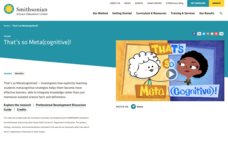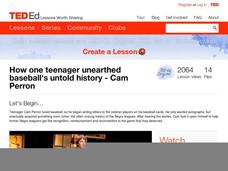Smithsonian Institution
‘Tis the Season for a Reason
The distance from the sun causes the seasons, right? Review common misconceptions that interfere with scholars' understanding of how the seasons of the year occur. A video from the Good Thinking PD series offers strategies for overcoming...
Smithsonian Institution
Chemical Reactions in Action
Learn from colleagues by initiating a professional development discussion. An episode from the Good Thinking series analyzes strategies for teaching chemical reactions. Using examples from the classroom, the video discusses the...
Smithsonian Institution
Time: It’s Like, so Deep
Time can be relative but sometimes it is relevant. Large numbers are difficult for pupils to imagine ... and large time scale even more so. A video presentation from the Good Thinking PD series offers tips for teachers to give learners a...
Smithsonian Institution
That’s so Meta(cognitive)!
Explicitly teaching metacognition strategies to pupils sometimes affects their learning potential. A PD video lesson from the Good Thinking series explores the concept and offers strategies for teachers to incorporate in their...
Smithsonian Institution
What’s the “Matter” With Cells and Atoms?
Science concepts often span multiple disciplines. Learn strategies for helping pupils make the connections more effectively using an episode from the Good Thinking PD series. The lesson focuses on the concept of cells and atoms as they...
Smithsonian Institution
Science: A Work in Progress
Science is best taught by connecting concepts rather than isolating topics. Using classroom examples, a video lesson highlights the importance of showing the interconnection of science concepts. The instruction includes strategies to...
Smithsonian Institution
Why Right Brained Is Wrong…Brained
The brain is an especially complex organ. A PD lesson from the Good Thinking series discusses the importance of not isolating processes to the right or left side of the brain. The instruction uses specific examples to illustrate how...
Smithsonian Institution
Attack the Knack
Motivation is a problem many scholars face—at any level. Use a helpful resource to light a fire and develop a growth mindset in young scholars. Praising effort is much more effective than praising correct answers and often leads to more...
Smithsonian Institution
Photosynthesis: Blinded by the Light
Turn misconceptions into learning opportunities. A video PD lesson from the Good Thinking series reviews common misconceptions pupils develop when learning about photosynthesis. A professional development guide offers a format for...
TED-Ed
The Paradox of Value
Wants and needs are often dependent on certain situations individuals find themselves in. The paradox of value explains value as having two meanings based partly on human satisfaction and choice. Watch a video that discusses certain...
TED-Ed
What is a Vector?
A vector contains magnitude and direction. The video and associated questions introduce the class to vectors that are made up of scalars and displacement. Pupils read more about vectors to find them in real life and how they are used in...
American Chemical Society
Can I Still Eat This?
The United States sends 133 billion pounds of edible food to landfills every year. A lesson from the ACS Reaction series discusses the chemical reactions that cause food to change over time. Some reactions make food taste different while...
TED-Ed
How One Teenager Unearthed Baseball's Untold History
Discover how one young man made a major impact on a generation of individuals through simple dedication, consideration, and passion for something he loved. Cam Perron discusses how after writing letters to retired baseball players from...
Sesame Street
Princess and the Elephant
Natalie Portman and Elmo put on a play and to show how to work together. They both want to be elephants so they work out a solution by changing the play. The video could be used as a way to discuss working out problems in the classroom,...
Sesame Street
Counting Bats with the Count: Four
Count the bats to find out today's number of the day. The Count counts three bats but nothing happens. He adds one more bat to the mix for a total of four, four wonderful bats. The number of the day is four.
TED-Ed
A Plant's-Eye View
Why is it important to look at the world from other species' points of view? Author Michael Pollan claims it is a way to reanimate the earth, realize Darwinian insights, and to take the food we need from the earth while healing it in the...
Crash Course
War & Expansion
How did the United States come to acquire two of its largest states? Your class members will learn about the sequence of events that led to and immediately followed the acquisition of Texas and California, including the Mexican-American...
Curated OER
Paper Fortune Tellers for Exploring Upsetting Emotions
What kinds of thoughts help us to cope with problems and approach difficult situations? Support learners on the autism spectrum in exploring their emotions and considering the connection between our thoughts and our feelings using one of...
Curated OER
Alphabet Letters Aa-Zz
In these alphabet letter worksheets, students color in the uppercase and lowercase letters from Aa through Zz. Students color 26 worksheets.
Other popular searches
- Edutainment Educational Games
- Fun Educational Games
- Educational Games .Com
- Educational Games in French
- Kids Educational Games
- On Line Educational Games
- Online Educational Games
- Educational Games Maths Ks3




















